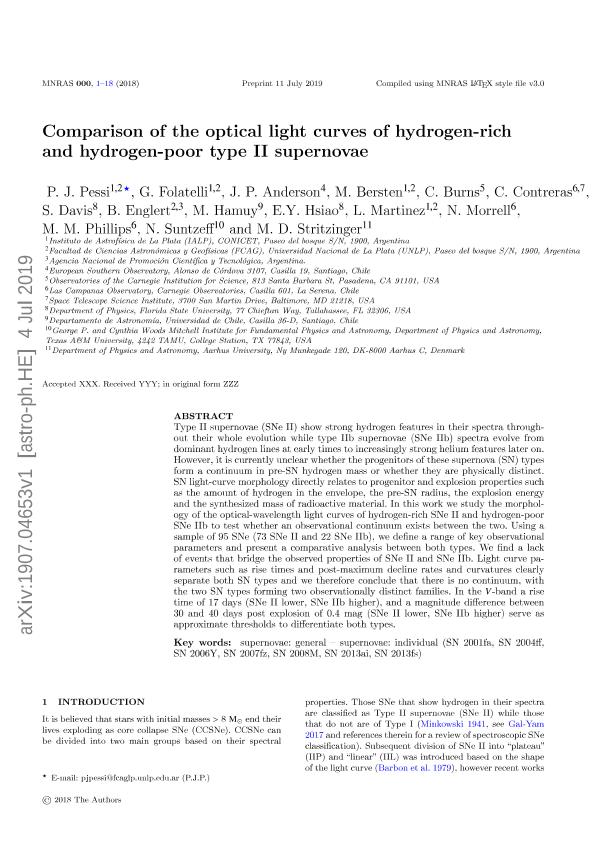Artículo
Comparison of the optical light curves of hydrogen-rich and hydrogen-poor type II supernovae
Pessi, Priscila Jael ; Folatelli, Gaston
; Folatelli, Gaston ; Anderson, J. P.; Bersten, Melina Cecilia
; Anderson, J. P.; Bersten, Melina Cecilia ; Burns, C.; Contreras, C.; Davis, S.; Englert Urrutia, Brenda Nahir; Hamuy, M.; Hsiao, Eric; Martinez, Laureano
; Burns, C.; Contreras, C.; Davis, S.; Englert Urrutia, Brenda Nahir; Hamuy, M.; Hsiao, Eric; Martinez, Laureano ; Morrell, Nidia Irene
; Morrell, Nidia Irene ; Phillips, M. M.; Suntzeff, N.; Stritzinger, M. D.
; Phillips, M. M.; Suntzeff, N.; Stritzinger, M. D.
 ; Folatelli, Gaston
; Folatelli, Gaston ; Anderson, J. P.; Bersten, Melina Cecilia
; Anderson, J. P.; Bersten, Melina Cecilia ; Burns, C.; Contreras, C.; Davis, S.; Englert Urrutia, Brenda Nahir; Hamuy, M.; Hsiao, Eric; Martinez, Laureano
; Burns, C.; Contreras, C.; Davis, S.; Englert Urrutia, Brenda Nahir; Hamuy, M.; Hsiao, Eric; Martinez, Laureano ; Morrell, Nidia Irene
; Morrell, Nidia Irene ; Phillips, M. M.; Suntzeff, N.; Stritzinger, M. D.
; Phillips, M. M.; Suntzeff, N.; Stritzinger, M. D.
Fecha de publicación:
11/07/2019
Editorial:
Wiley Blackwell Publishing, Inc
Revista:
Monthly Notices of the Royal Astronomical Society
ISSN:
0035-8711
Idioma:
Inglés
Tipo de recurso:
Artículo publicado
Clasificación temática:
Resumen
Type II supernovae (SNe II) show strong hydrogen features in their spectra throughout their whole evolution, while type IIb supernovae (SNe IIb) spectra evolve from dominant hydrogen lines at early times to increasingly strong helium features later on. However, it is currently unclear whether the progenitors of these SN types form a continuum in pre-SN hydrogen mass or whether they are physically distinct. SN light-curve morphology directly relates to progenitor and explosion properties such as the amount of hydrogen in the envelope, the pre-SN radius, the explosion energy, and the synthesized mass of radioactive material. In this work, we study the morphology of the optical-wavelength light curves of hydrogen-rich SNe II and hydrogen-poor SNe IIb to test whether an observational continuum exists between the two. Using a sample of 95 SNe (73 SNe II and 22 SNe IIb), we define a range of key observational parameters and present a comparative analysis between both types. We find a lack of events that bridge the observed properties of SNe II and IIb. Light-curve parameters such as rise times and post-maximum decline rates and curvatures clearly separate both SN types and we therefore conclude that there is no continuum, with the two SN types forming two observationally distinct families. In the V band a rise time of 17 d (SNe II lower and SNe IIb higher), and a magnitude difference between 30 and 40 d post-explosion of 0.4 mag (SNe II lower and SNe IIb higher) serve as approximate thresholds to differentiate both types.
Archivos asociados
Licencia
Identificadores
Colecciones
Articulos(IALP)
Articulos de INST.DE ASTROFISICA LA PLATA
Articulos de INST.DE ASTROFISICA LA PLATA
Citación
Pessi, Priscila Jael; Folatelli, Gaston; Anderson, J. P.; Bersten, Melina Cecilia; Burns, C.; et al.; Comparison of the optical light curves of hydrogen-rich and hydrogen-poor type II supernovae; Wiley Blackwell Publishing, Inc; Monthly Notices of the Royal Astronomical Society; 488; 3; 11-7-2019; 4239-4257
Compartir
Altmétricas



